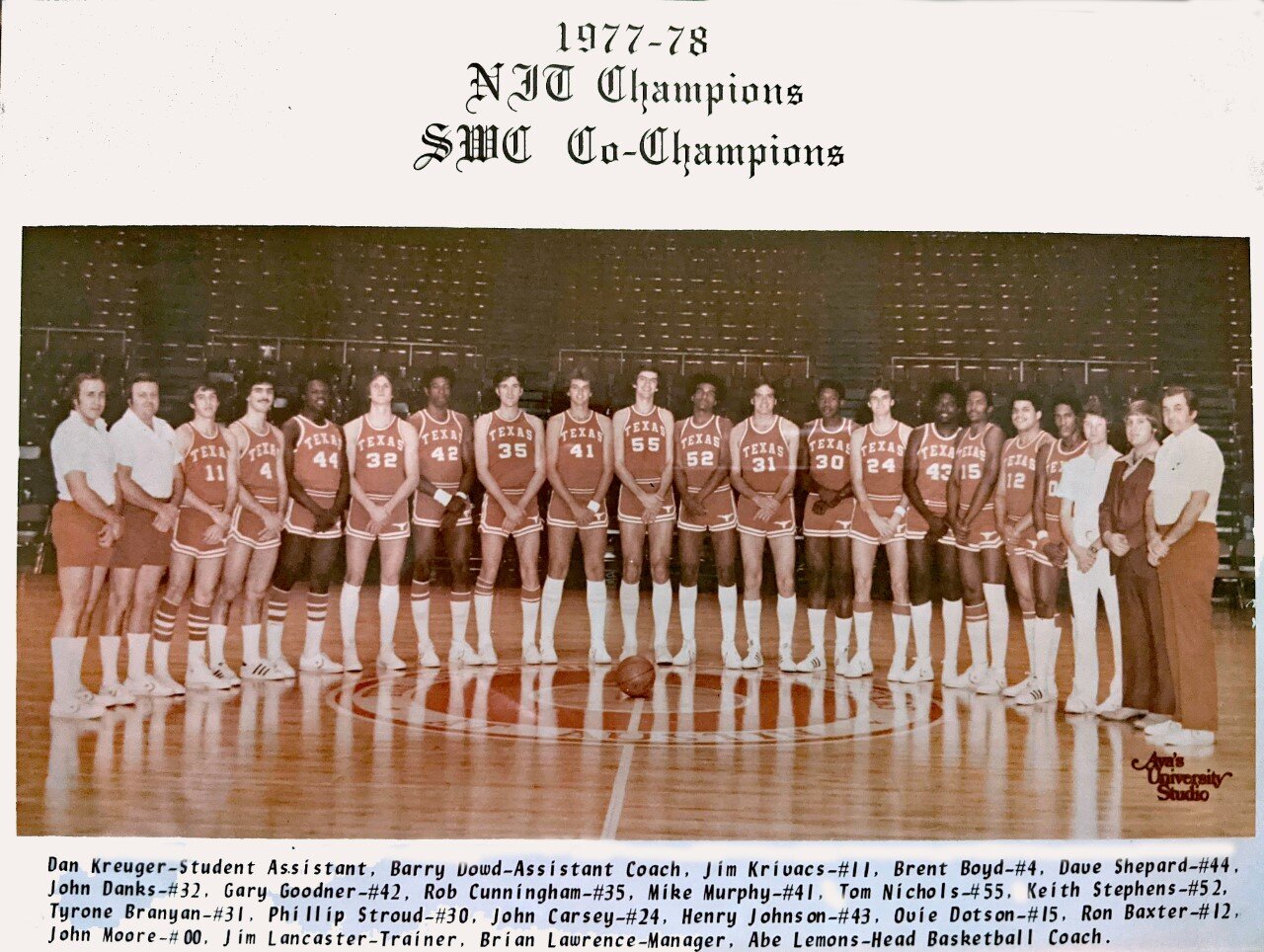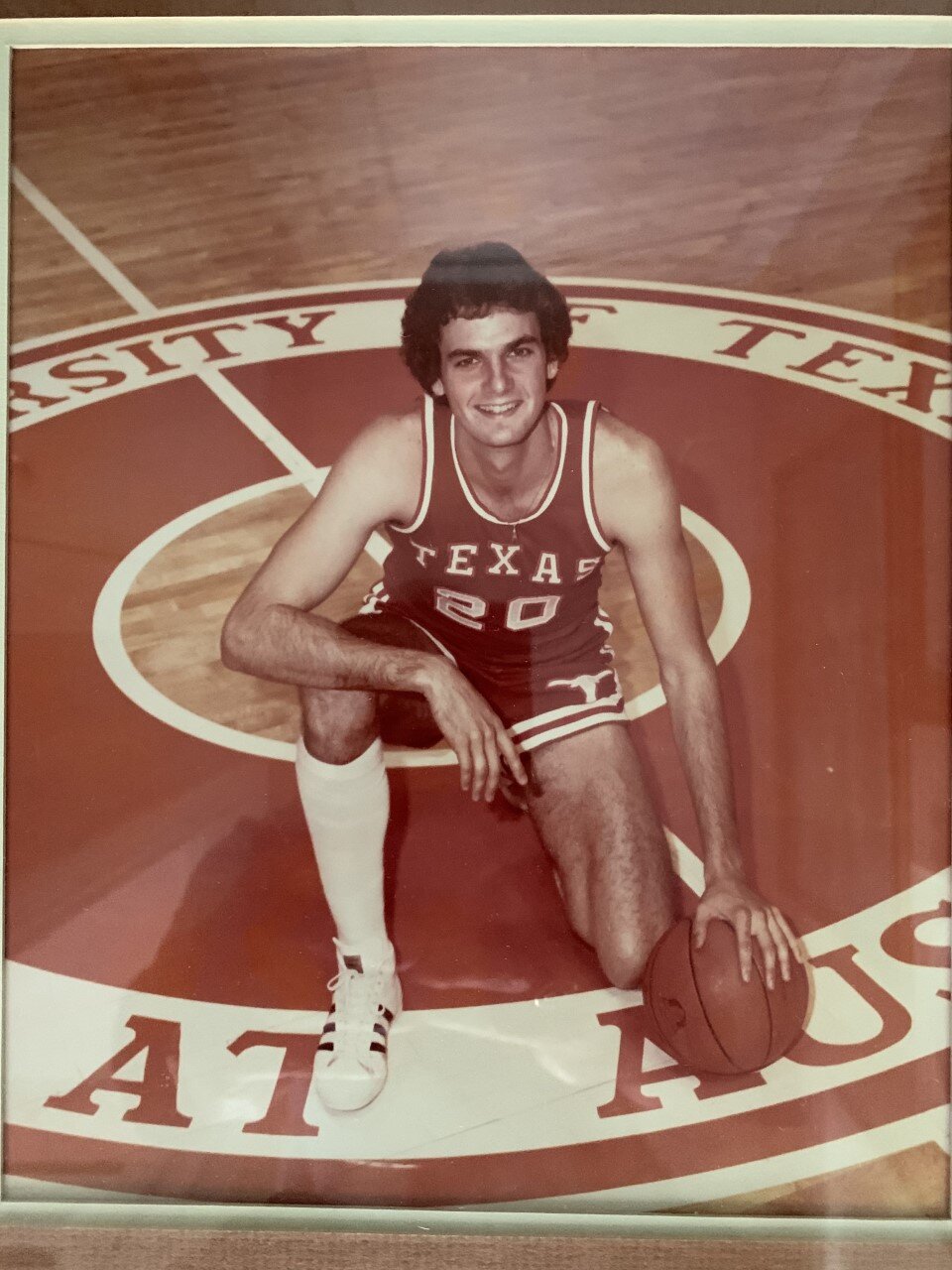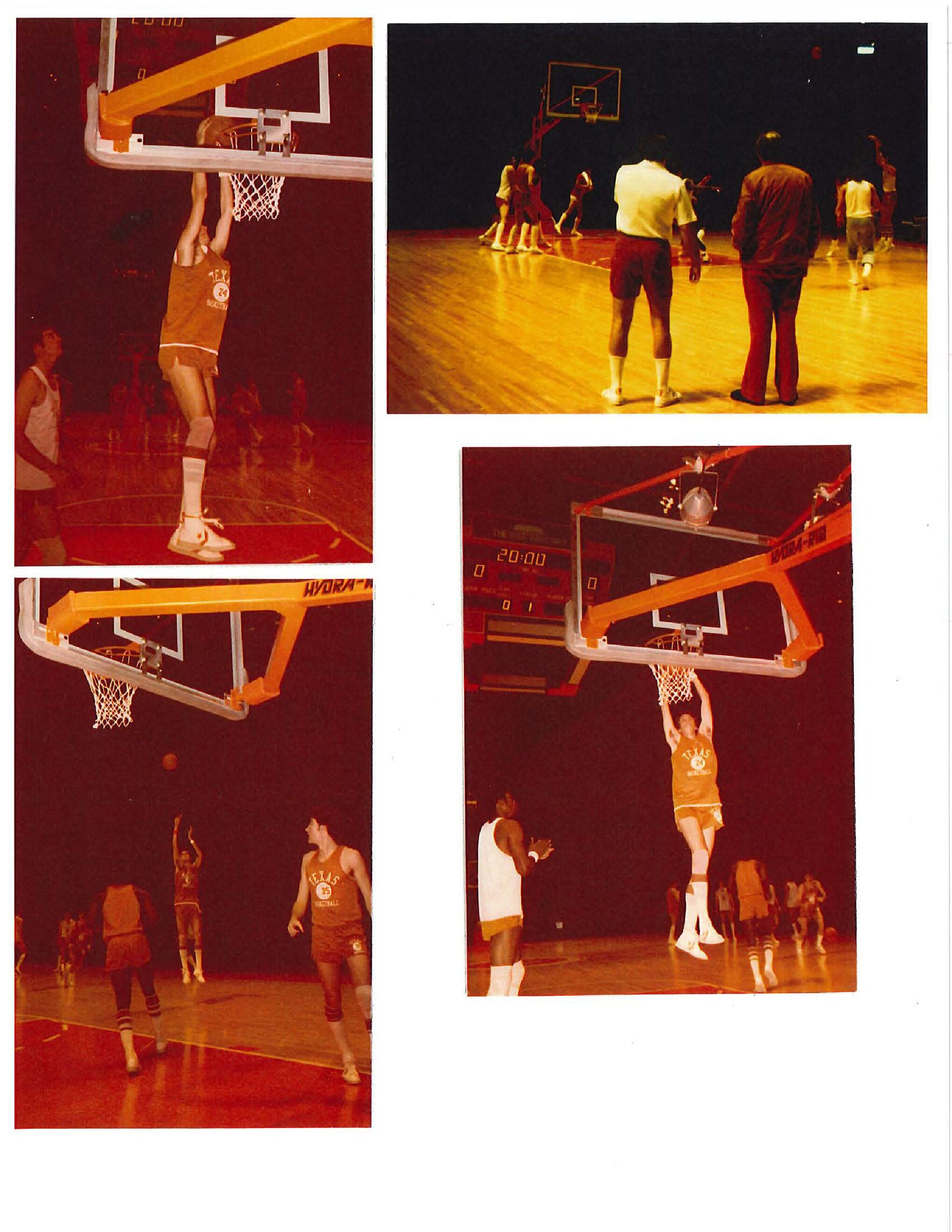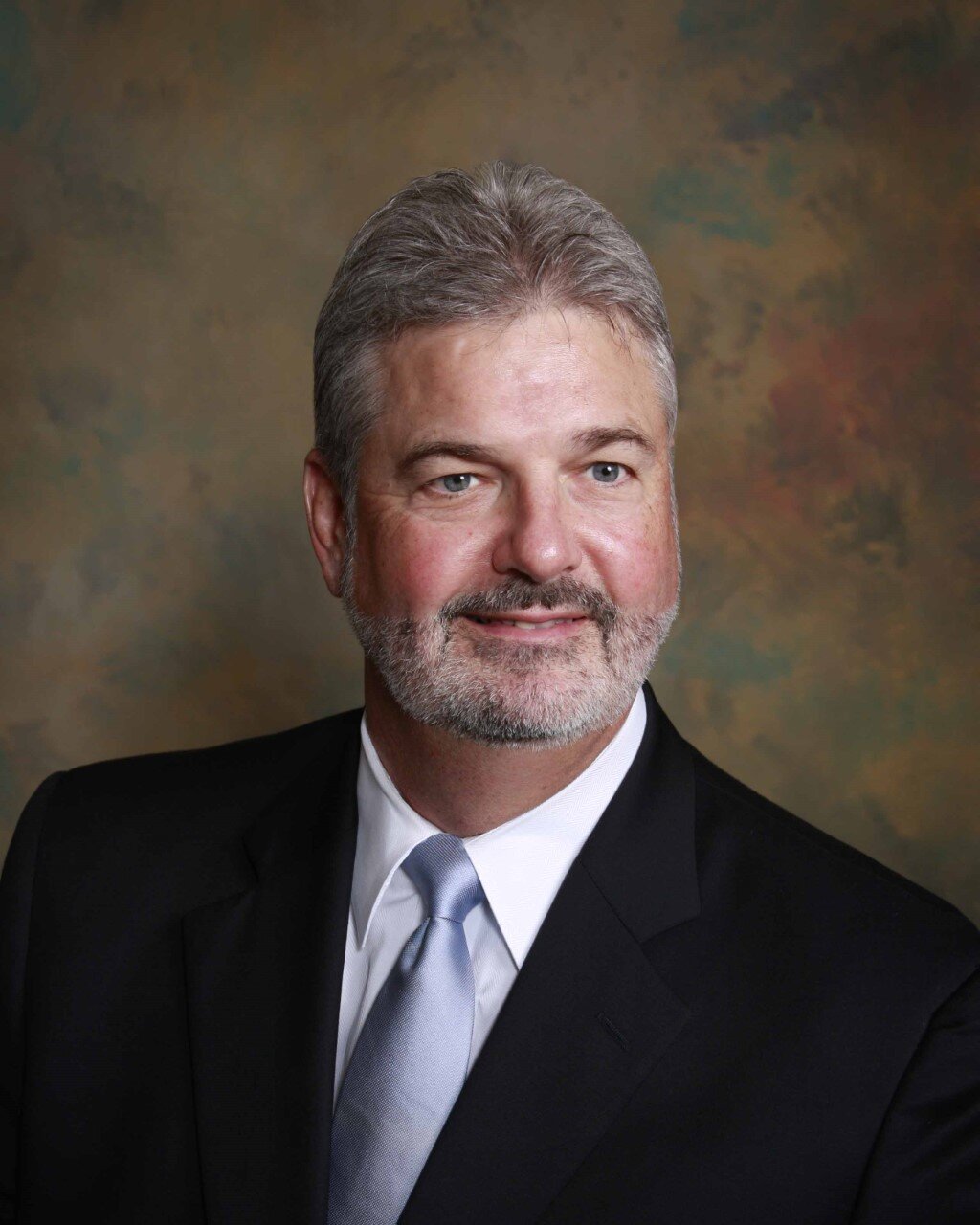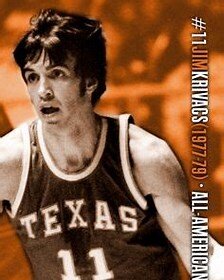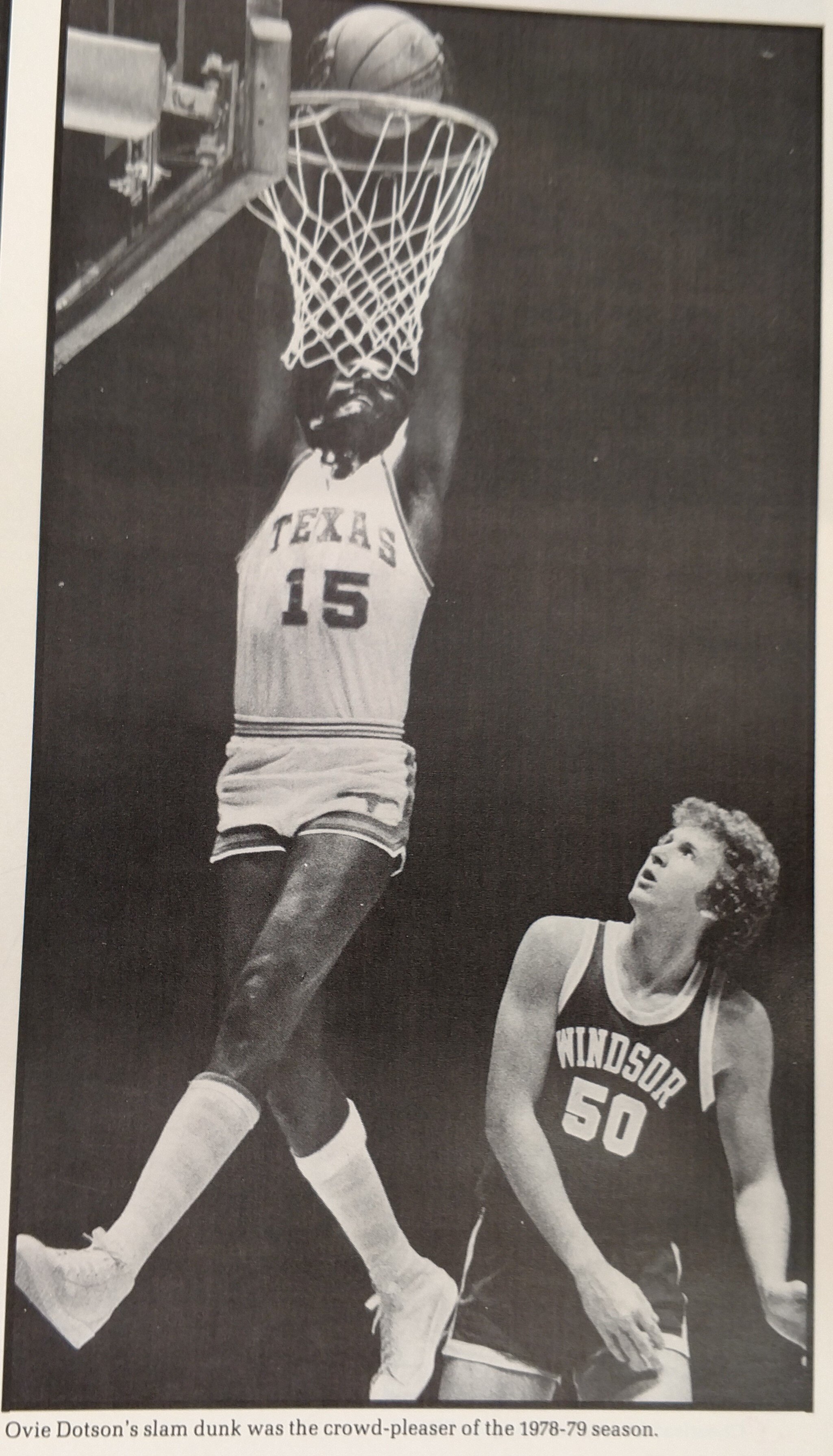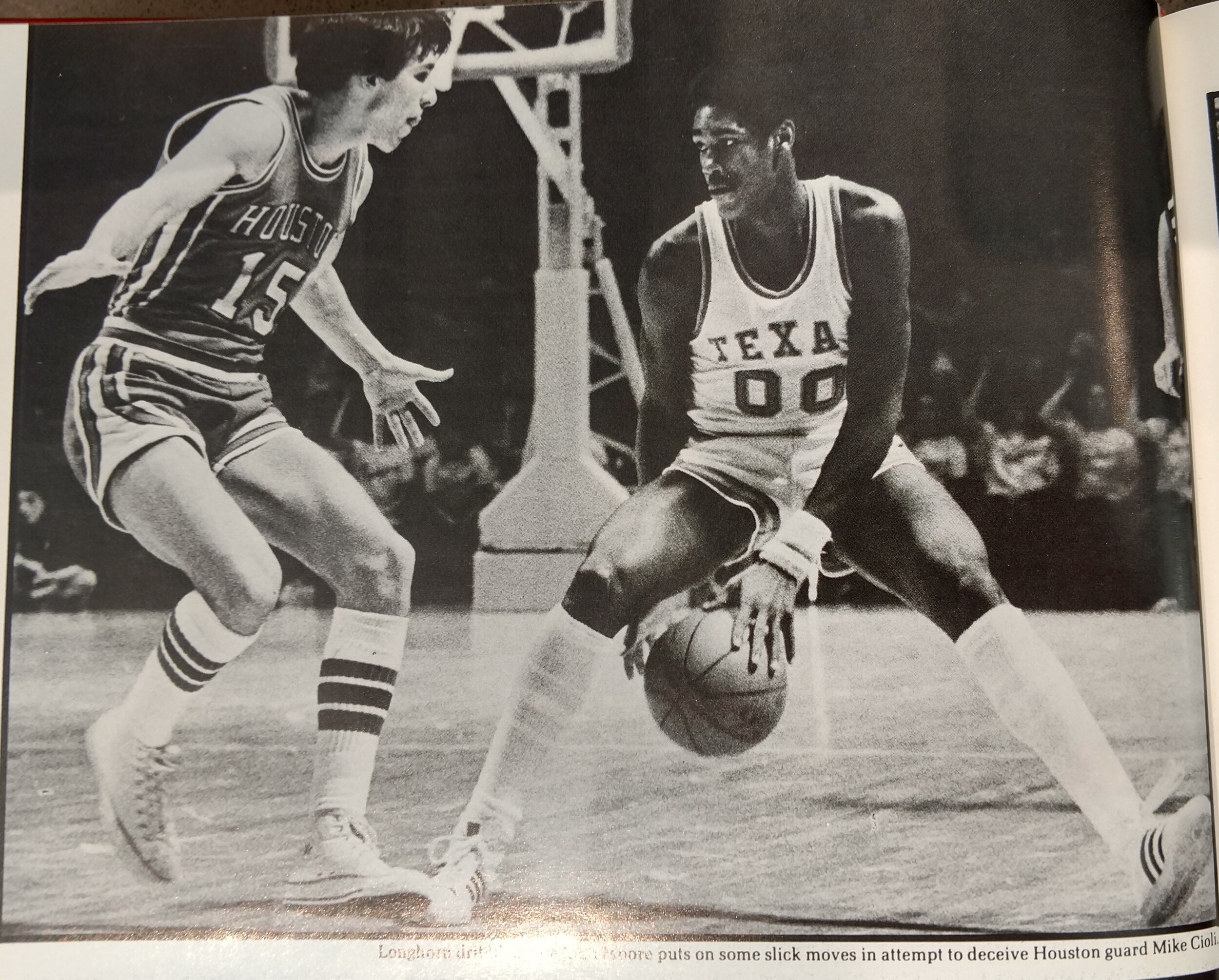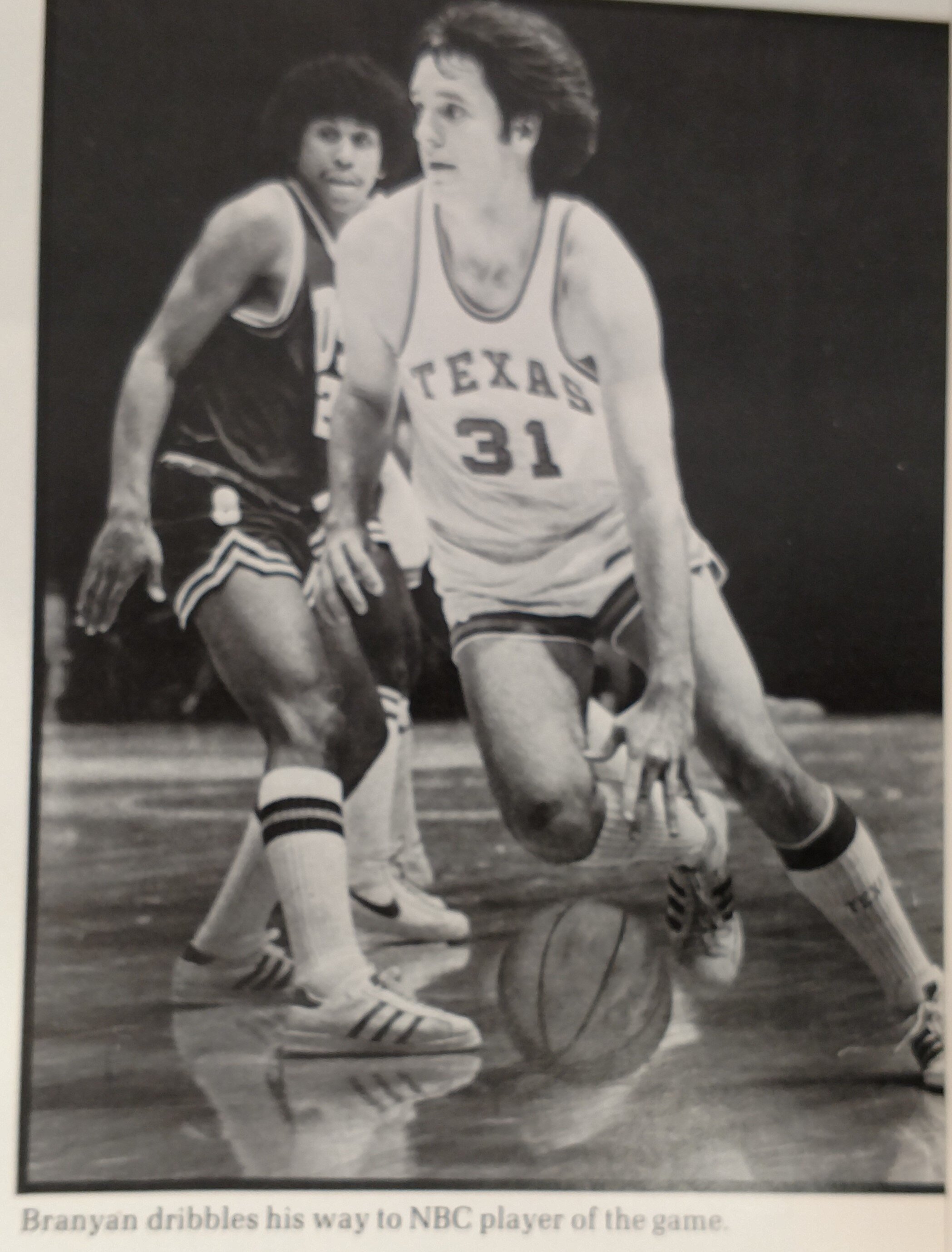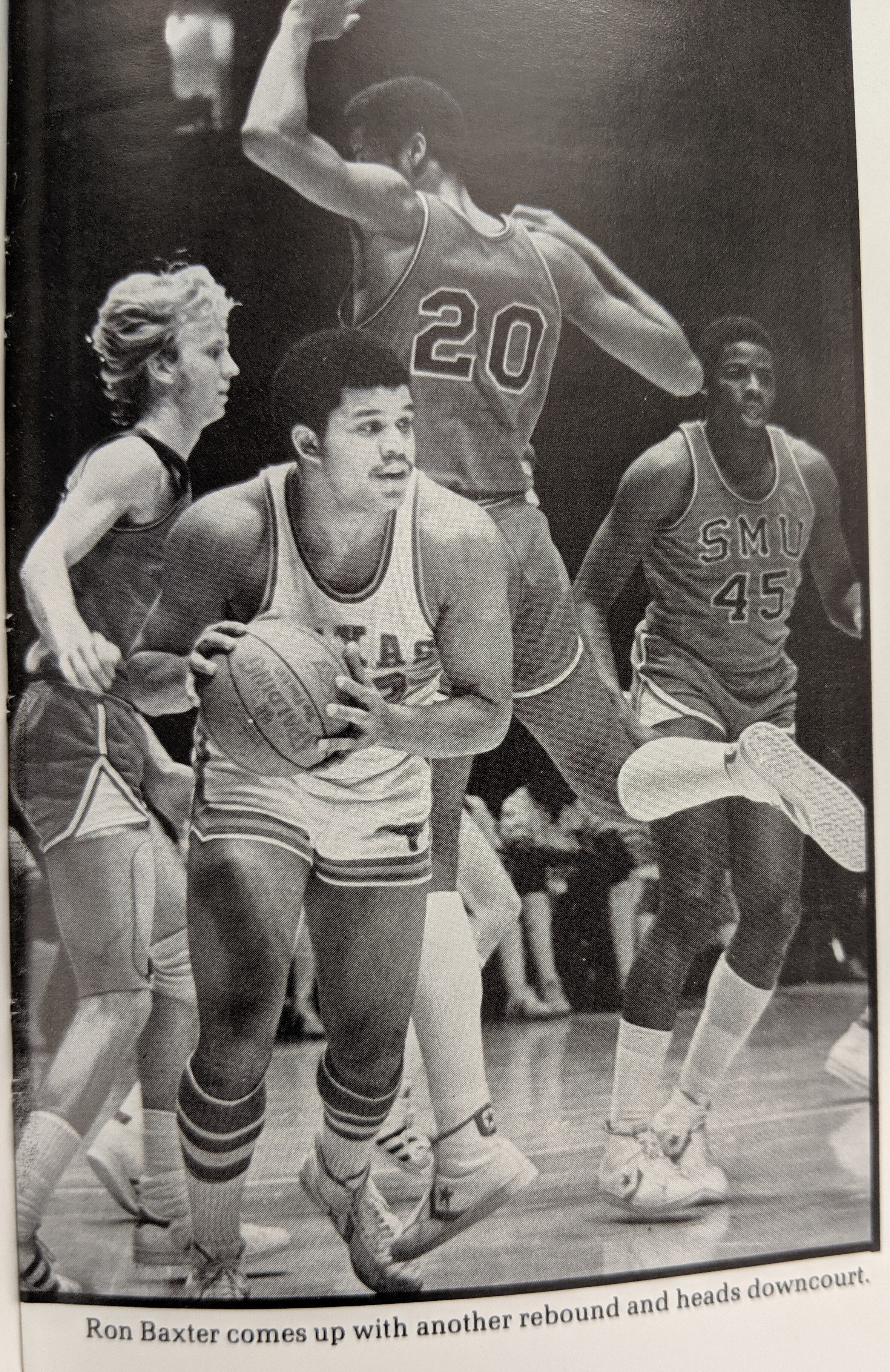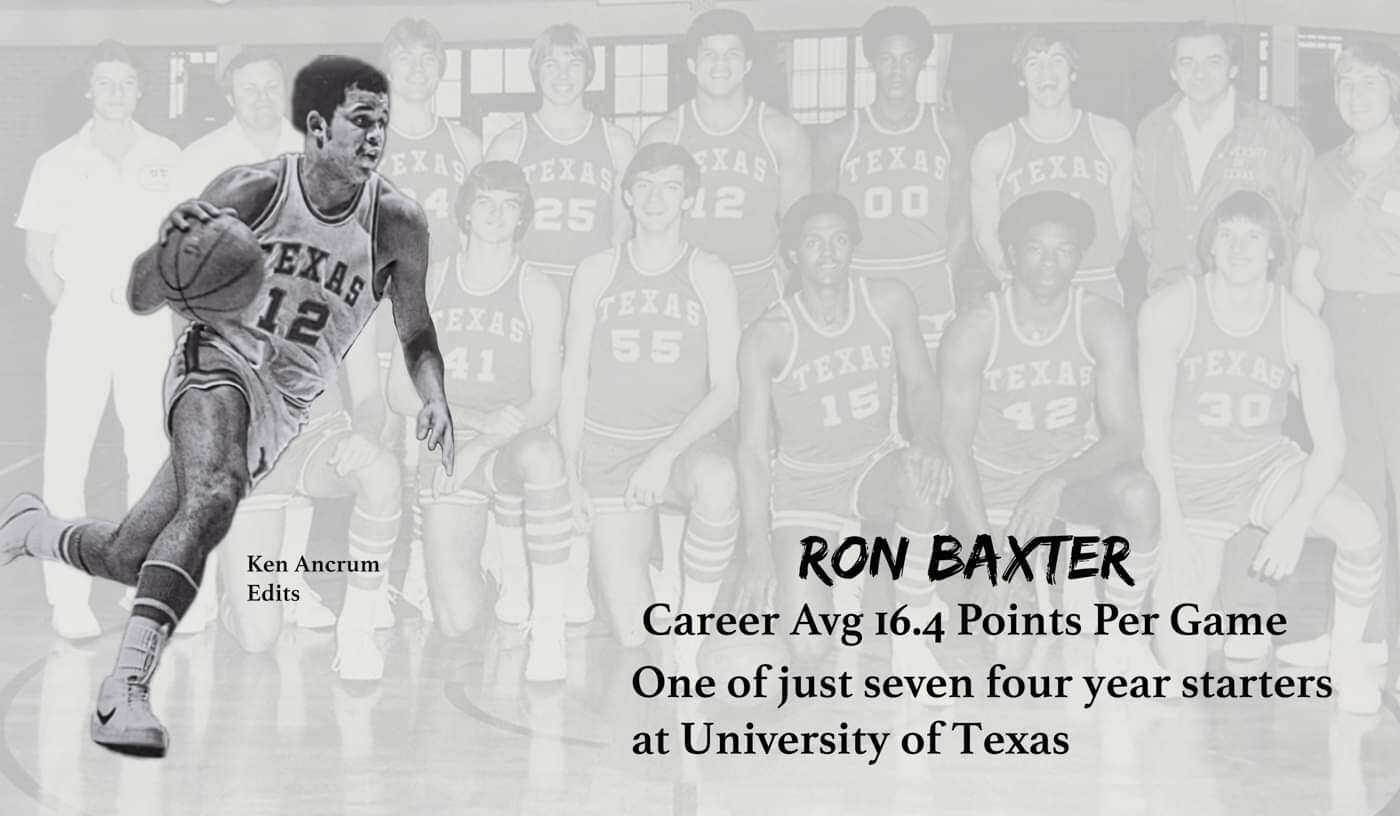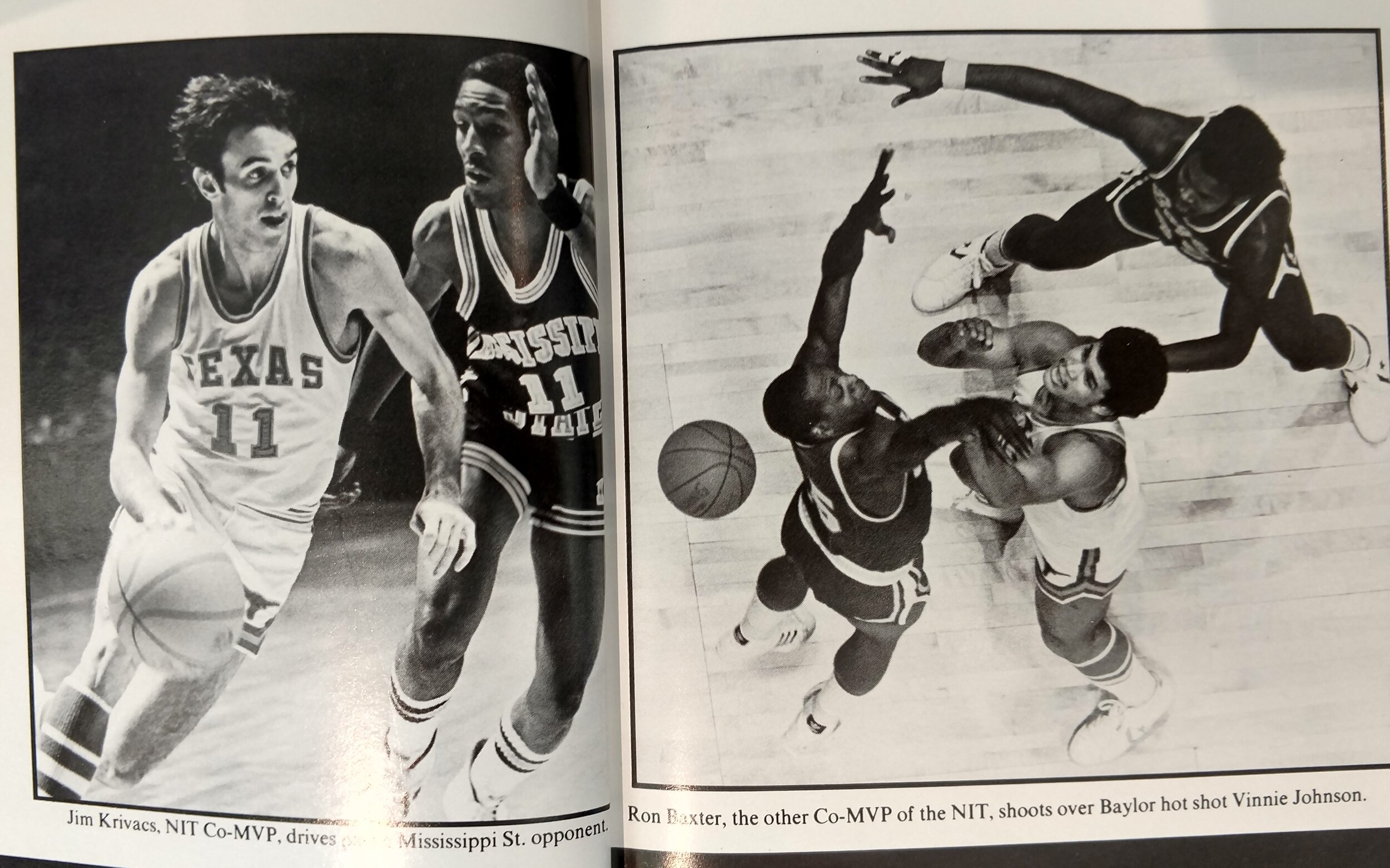Our 1977 – 78 team was the 1st team to play in the Special Events Center and we did go undefeated at home. John’s right about the sellouts. After our inaugural season at the Drum, it was reported that we’d averaged the 3rd largest home attendance in the nation. I think that the average attendance for that season was around 12,800.
You do a fantastic job chronicling the history of the Horns!
Go Horns Go,
Tom
Tom Nichols
1974-1978
Longhorn Basketball
John Carsey Audio history of Longhorn basketball chronicles the 1977 NIT Championship won by Ron Baxter, Johnny Moore, John Danks, Tyrone Lee Branyan, Jim Krivacs, Gary Goodner, Ovie Dotson, and many others who are depicted on the banner page above.
listen to the oral history as told through the Eyes of Texas John Carsey . Podcast link is in black rectangle below.
1976
Abe Lemon Says That 1976 Is His Toughest Year As A Coach. He says"We're Still Looking For Someone Who Likes To Play Defense And Has That Rare Talent Of Running To The Other End And Throwing The Ball In The Basket."
In 1976 Lemons had to hold the players’ hands on every play saying, “Please pass the ball. Please shoot. Please move to that spot.” He said in 1976, “Heck, we’re going to have a tough game Thursday against an open (week) .”
In an interview with “Sports Illustrated,” Lemons says, “there are players on this team who are not even interested in basketball. One afternoon I told them to do wind sprints, and one of them said he didn’t want to. I said, 'ok, you go stand over there.’ I asked who else didn’t want to do wind sprints. Three of my starters walked over and stood with this guy. I thought that was bad, but yesterday they were so apathetic that I chased them off.” Abe says about the 1976 team, “My plays are devised to get a guy open for a shot, but my guys don’t like to shoot when they are open. They only like to shoot if they can jump and twist. Tonight the plays are changed so the shooter will be almost open but not quite. Maybe my guys can throw some to them twisty shots into the bucket.”
John Carsey says, “While we certainly had our stars, particularly the Big Three of Johnny Moore, Ron Baxter, and Jim Krivacs, no player (even the lone walk-on) was made to feel lesser. We all appreciated that it was a total team effort to push everyone to be better, and there was no class system.
“One of Coach Lemons’ motivational tools was using each practice between games as a “tryout” for the next game. Nobody’s “job” was secure. We scrimmaged with the starters from the last game wearing white jerseys, and the rest in orange. If at any time during practice Coach felt that an orange-jersey player was more deserving at that moment of starting the next game, he would have that player switch jerseys with whichever player in a white jersey he felt was faltering. Whichever five were wearing white jerseys at the end of the last practice prior to the next game were the starters for that game.”
Jim Krivacs
After a ten year ban, the dunk is reinstated but not allowed during warm-ups. A Mississippi State player warming up before the Texas game dunks the ball and is called for a two-shot technical foul. Abe Lemons is incensed at such a ridiculous rule tells Krivacs to take the technical with his back to the basket.
Krivacs misses both, and Texas loses the game 91-89.
Abe says about Jim Krivacs, "If you gave him a choice of a week in Acapulco or a week of practice, he'd take practice. If you live in the gym like he does, you're going to be better. A lot of guys don't realize that. They think they're gonna have a vision one night and just play better."
Coach Lemons is concerned about the health of Jim Krivacs and tells the press, "Krivacs looks like he just came off a death march."
In one game, he can't get the attention of Jim Krivacs, so he taps a Houston player on the shoulder and says to him, please tap Jim Krivacs on the shoulder and tell him to run play #2. The Houston player did as instructed.
For the first time in the history of Gregory Gym, the field house is sold-out for two consecutive basketball games.
1977
Horns were the first team in the SWC to win the NIT.
1977 marked the Longhorns’ move to the new Frank Erwin Special Events Center (the “Drum”). In just Abe Lemons’ second season at the helm, they were undefeated in the Drum that inaugural season, finished the season 26-5 overall, tied Arkansas for the SWC regular season title with a 14–2 record, and won the 1978 National Invitation Tournament in convincing fashion.”
During the 1977 and 1978 season Longhorn fans often felt they had gotten more than their money’s worth watching the Horns play basketball.
Texas ends its first year in the Frank Erwin Center as the first SWC team to win the NIT.
12 Games At Gregory In 1977 Net $55,000. 8 Games In The New Arena In 1977 Net $275,000.
Ovie Dotson
Lemons says, “Ovie may be our most valuable player. His spirit, his character, is much of our driving force. If I had a son, I’d like him to be just like Ovie.”
Ovie’s style of play always excited the fans. Once at the end of a game, Ovie went to-the-knees and-behind-the-head slam dunk that ended the game and caused pandemonium in the Super Drum. Sportscaster Al McGuire said, “What threw me most was how the fans screamed when Dotson did the slam dunk…the noise was really unbelievable.”
Ovie had a successful career with the Harlem Globetrotters after he graduated from Texas.
Preparing for the NIT Tournament
The NIT President tells Lemons that if the Longhorns beat Temple, the Horns will play their next opponent in the Drum in Austin. Someone with lesser status with the NIT promises Nebraska that their home court would be used if they beat their first opponent. Lemons refuses to flip a coin for the home court with Nebraska, and the Cornhusker fans are livid. One member of the Nebraska Board of Directors says, "his school should break athletic ties with Texas." Abe responds, "I didn't know we had any."
Branyan and Krivacs scored a total of 49 points in the semi-finals in the NIT championship game. Johnny Moore, Ron Baxter, and Krivacs scored 81 points in the finals against NC State.
John Moore
Abe Lemons's policy is to talk to only one team member during one-minute time-outs. He says, "I talk to my quarterback, and he tells the other players, and they take it better coming from him." Johnny Moore was that man in 1976.
Following his Longhorn career, Moore signed with the San Antonio Spurs. Over ten years and 520 games in his NBA career, Moore averaged 7.4 assists. He recorded 20 assists in three games, once during the playoffs, making him one of only seven players to record 20 assists or more in a playoff game. He also had two games of nine or more steals in a game, one of only 50 different players to record nine or more steals in a game. Moore retired as the then all-time assist leader in Spurs history and is one of ten players to have his number ("00") retired by the Spurs.
Abe, trying to put his 1978 basketball schedule together after winning the NIT in 1977, says to potential opponents, "If you think we're easy, get on our schedule." "Come on down and pick-up up an easy win." Six of the teams that agreed to play Texas in 1978 canceled their commitment after the 1977 Longhorns shocked the world.
1978 21-8 RECORD - COACH LEMONS
In 1978 the Longhorns continued their dominance at the Drum, posting a 12-1 home record, again tied Arkansas for the SWC regular-season title with a 13–3 record, finished the season 21-8 overall, and received their first bid to the NCAA Tournament in 5 years.
TYRONE BRANYAN
Abe says Tyrone Branyan is too slow and can't jump, but "he knows how to win." In the Texas miracle win over Houston in 1977, Tyrone hits 6 of 8 free throws and finishes the game with 16 points and ten rebounds.
PART OF A SPORTS ILLUSTRATED ARTICLE ABOUT TYRONE BRANYAN #31 AS TOLD BY SPORTS ILLUSTRATED FEBRUARY 12, 1979 IT'S NOT A LONE STAR STATE THE LONGHORNS AND AGGIES ARE TIED FOR FIRST IN THE SWC, MAINLY BECAUSE OF A FORWARD WHO'S BETTER THAN HE THINKS HE IS AND A CENTER WHO MAY BE AS GOOD AS HE SAYS HE IS. BY LARRY KEITH
6'7" Tyrone Branyan does not run fast or jump high or have a perfect shooter form, but halfway through the 1978 seasons, he led the Longhorns with Tyrone averaging 18.2 points and 7.44 rebounds a game.
Branyan plays a lot better than he looks. Texas Coach Abe Lemons took Branyan without ever seeing him play, which may have been to Lemons' advantage.
Lemons probably would never have seen—or even heard of—Branyan had it not been for George Brewer, a friend of Tyrone's father and a former football teammate of Texas Athletic Director Darrell Royal. When Branyan was a sophomore at Cypress Junior College in California, Brewer wrote Royal about him, and Royal passed the letter on to Lemons.
Abe had never heard of Branyan, but the letter sounded so interesting that he sought a more detailed evaluation from Tyrone's junior-college coach. Lemons liked the coach's report enough that he gave Branyan a scholarship sight unseen. Only then did he dispatch Assistant Coach Barry Dowd to check him out.
After watching Branyan play in a junior-college tournament, Dowd called Lemons and said, "Picture a guy who can't jump, can't run and shoots funny. Now picture him with 24 points, 17 rebounds and the Most Valuable Player trophy in the championship game."
Lemons was overjoyed—until he actually saw Branyan himself the next fall. As is his custom, Branyan was in poor shape when he showed up for preseason workouts, and he was anything but impressive on the practice floor. When he got a chance to play, Lemons says, "People were aghast." However, by the second conference game Branyan was a starter, and he finished the year with respectable averages of 12.8 points and 5.7 rebounds. "If Tyrone could jump up and spin around twice and then score," says Lemons, "everybody would ooh and aah. But he isn't that kind of player. He's exceeded my expectations by about a million."
The oddest thing about Branyan is the way he shoots his jump shot—off his chest. The best thing about him is the way his teams always win.
Respect is something Branyan has learned to live without. Instead of reveling in his success, he questions it, scoffing at the suggestion that he or his team is anything special. "It's hard for me to think we're as good as the top teams," he says. "I guess I still look up to those people, because I never thought I could play ”, and Texas can thank Branyan for its semi-lofty status. He is averaging 18.2 points and 7.4 rebounds and has been the only consistent performer during Texas' 16-5 season.
Ron Baxter
In the book Abe Lemons Court Magician by Bob Burke and Kenny Franks, Abe Lemons said I like to recruit "a wild guy, somebody that's stung by a bee." "I like a wild horse that just tears up the gym." "I like people with unusual characteristics that you can calm down and help make something of." Abe liked players that had been given nicknames from his teammates, such as "adding machine" or the "helicopter."
On his first recruiting trip to California as the Longhorn head coach, he found an individual that qualified for his "type" of a recruit.
Ron Baxter was Abe Lemons's first great recruit at Texas. Ron was the high school co-player of the year in Los Angeles. Abe says, "I saw him (Ron) play against the Russians." "The Russians even brought their official." "Talk about a crook." The local paper after the game says, "Russians introduce six-man basketball to the U.S." Abe saw a lot of potential in Ron during the game, even though Coach Lemons criticized his play, saying, "Baxter passes too much" "Doesn't shoot enough." "Shot only twice against the Russians." "He made one." Abe knew that Ron was a great athlete, and he just needed a coach who would encourage him to shoot more.
Ron says he chose UT over other schools because Abe convinced him he could build a great program. In the book "You Scored One More Point Than a Dead Man," organized by Robert Heard, Ron Baxter says about Coach Lemons style, "There was none of this, 'You'll have breakfast at seven, and you do such and such at 8:00 and …..' He did not act like a coach." Baxter also liked his tart tongue. "He cut me up pretty good for not moving down the baseline one time when I was inbounding against a full-court press, and he told me I couldn't get open (for a shot) if a dead man guarded me, and that I couldn't hit the basket with a shotgun."
In the book, Abe Lemons Court Magician Ron tells a story about how he learned the difference between Abe coaching at practice and Abe at all other times. He says one day at practice, "From the moment he grabbed my shirt, I knew this man was business in practice. He might have said some funny things to loosen us up, but he demanded my attention every moment in every exercise. I knew if I wanted to play, I had to go all out in practice."
Baxter Loved The Lemons System Saying "It's Take The Quick, Good Shot." "You Just Play Basketball." "If You Can Get Open Inside 20 Feet, You Take Your Shot". "We Ran A Stack To Get The Ball To Jim Krivacs On The Baseline." "If Not, It's Free Lance And Goes One On One." Ron Baxter Says Lemon Coached To His Players Ability". He Does Not "Make Them Fit Into A System." "He Is The Best Sideline Coach In The Nation."
Abe was not one to pass out compliments easily. The player had to earn his praise. Abe says about Ron, "From the standpoint of basketball instinct, and the ability to do so many things so well, he's as good a freshman as I've ever had."
Baxter took some heavy hits from the New York media about his weight. Before the NIT Final Four in New York, Texas was playing Rutgers and Georgetown was playing N.C. State in the semis. It was a public shoot around and Georgetown coach John Thompson is standing with Abe when he points at Ron and says: "Who is the fat kid? Abe answers: "He's my best player." Thompson retorts, “I figured he was either your star or kinfolk.”
Baxter proved Abe right. Baxter was CO-MVP of the NIT tournament scoring 26 points. In all 4 tournament games he scored 71 points and had a a tournament high 41 rebounds. Marquette’s 6-10” Jerome Whitehead said about Baxter “they had a 6’4” guy (Ron Baxter) who was pounding everybody up.”
Ron says about Lemons match-up zone defense, "his (Lemons) defenses are extremely complex, but they're effective. A couple of teams had no idea of how to attack our defense; they didn't even know what defense we were running."


